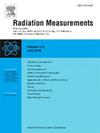Modified Uniformly Redundant Array coded aperture design by MCNP simulation for neutron imaging with Timepix
IF 2.2
3区 物理与天体物理
Q2 NUCLEAR SCIENCE & TECHNOLOGY
引用次数: 0
Abstract
Accurate identification of radioactive hotspots is essential to the nuclear industry, especially for decommissioning operations, waste management, radiation protection, nuclear research, and homeland security applications. In certain cases, the detection of fast neutron emissions is particularly important when gamma imaging techniques reach their limits. CEA List presented a highly compact, (19 × 14 × 15) cm3 and 2.2 kg, fast neutron/gamma imager based on a Modified Uniformly Redundant Array coded aperture, a Timepix detector enhanced with of a paraffin layer and specific processing algorithms. A first prototype was designed and the feasibility of coded aperture fast neutron imaging was demonstrated with these technologies integrated in the GAMPIX gamma camera prototype. However, the fast neutron imaging capability has not yet been fully evaluated and optimized in terms of encoding capacity, field of view and angular resolution.
This paper presents a comprehensive analysis of how coded aperture characteristics—such as material, rank, and thickness—affect the imaging performance of our fast-neutron imager using Monte Carlo simulations. The study highlights the significant impact these parameters have on sensitivity, spatial resolution, and field of view, thereby contributing to the optimization of neutron imaging systems and filling an important gap in existing research.
基于Timepix中子成像的改进均匀冗余阵列编码孔径设计
准确识别放射性热点对核工业至关重要,特别是在退役操作、废物管理、辐射防护、核研究和国土安全应用方面。在某些情况下,当伽马成像技术达到极限时,快中子发射的探测尤为重要。CEA List展示了一个高度紧凑的(19 × 14 × 15) cm3, 2.2 kg,基于改进均匀冗余阵列编码孔径的快中子/伽马成像仪,一个经过石蜡层和特定处理算法增强的Timepix探测器。设计了第一台原型机,并将这些技术集成到GAMPIX伽玛相机原型机中,验证了编码孔径快中子成像的可行性。然而,快中子成像能力在编码能力、视场和角度分辨率等方面还没有得到充分的评价和优化。本文综合分析了编码孔径特性(如材料、等级和厚度)对快中子成像仪成像性能的影响。该研究强调了这些参数对灵敏度、空间分辨率和视场的重要影响,从而有助于中子成像系统的优化,填补了现有研究的重要空白。
本文章由计算机程序翻译,如有差异,请以英文原文为准。
求助全文
约1分钟内获得全文
求助全文
来源期刊

Radiation Measurements
工程技术-核科学技术
CiteScore
4.10
自引率
20.00%
发文量
116
审稿时长
48 days
期刊介绍:
The journal seeks to publish papers that present advances in the following areas: spontaneous and stimulated luminescence (including scintillating materials, thermoluminescence, and optically stimulated luminescence); electron spin resonance of natural and synthetic materials; the physics, design and performance of radiation measurements (including computational modelling such as electronic transport simulations); the novel basic aspects of radiation measurement in medical physics. Studies of energy-transfer phenomena, track physics and microdosimetry are also of interest to the journal.
Applications relevant to the journal, particularly where they present novel detection techniques, novel analytical approaches or novel materials, include: personal dosimetry (including dosimetric quantities, active/electronic and passive monitoring techniques for photon, neutron and charged-particle exposures); environmental dosimetry (including methodological advances and predictive models related to radon, but generally excluding local survey results of radon where the main aim is to establish the radiation risk to populations); cosmic and high-energy radiation measurements (including dosimetry, space radiation effects, and single event upsets); dosimetry-based archaeological and Quaternary dating; dosimetry-based approaches to thermochronometry; accident and retrospective dosimetry (including activation detectors), and dosimetry and measurements related to medical applications.
 求助内容:
求助内容: 应助结果提醒方式:
应助结果提醒方式:


